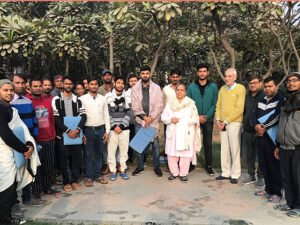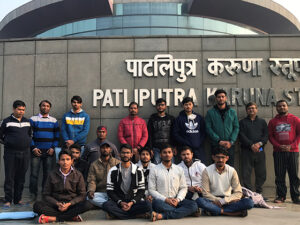Life is full of sorrows and sufferings. The suffering is due to craving, aversion, and ignorance. We acquired cravings and aversion towards something through our habit patterns and socialization. Those states of mind are not permanent. Vipassana is a process to gain liberation from suffering.
Rajesh Sinha/HE Times/Health Desk/18.02.2021
Meditation and mindfulness have become quite popular in recent years—yet most people can’t really define meditation, understand its purpose, or appreciate what meditation is good for. Meditation isn’t about becoming a different person, a new person, or even a better person.
Meditation can give you a sense of calm, peace and balance that can benefit both your emotional well-being and your overall health. The practice is usually done individually, in a still seated position, and with eyes closed.
The Mindfulness Meditation technique, which has become extremely popular in the West, is based on the teachings of the Buddha. Mindfulness meditation can be instrumental in helping us understand how our minds work. This self-knowledge serves as a foundation for overcoming dissatisfaction, impatience, intolerance and many of the other habits that keep us from living fuller, happier lives.

Vipassana Meditation
Vipassana, which means to see things as they really are, is one of India’s most ancient techniques of meditation. It was rediscovered by Gotama Buddha more than 2500 years ago and was taught by him as a universal remedy for universal ills, i.e., an Art Of Living. This non-sectarian technique aims for the total eradication of mental impurities and the resultant highest happiness of full liberation. Like other forms of meditation, Vipassana is beneficial for both your mind and body.
Vipassana can be translated as “Insight,” a clear awareness of exactly what is happening as it happens. Samatha can be translated as “concentration” or “tranquility.” It is a state in which the mind is brought to rest, focused only on one item and not allowed to wander. When this is done, a deep calm pervades body and mind, a state of tranquility which must be experienced to be understood.
Ten-day residential course
A ten-day residential course is an introductory course to Vipassana Meditation where the technique is taught step-by-step each day. The courses begin on the start date after registration period and orientation, followed by 10 full days of meditation. Courses end on the morning of the 11th day by 7:00 am.

Course Structure
To learn Vipassana, it is necessary to take a ten-day residential course under the guidance of a qualified teacher. The courses are conducted at established Vipassana Centers and other places. For the duration of the retreat, students remain within the course site having no contact with the outer world. They refrain from reading and writing, and suspend all religious practices or other disciplines. During the course, participants follow a prescribed Code of Discipline. They also observe noble silence by not communicating with fellow students; however, they are free to discuss meditation questions with the teacher and material problems with the management.
The entire practice is actually a mental training. Just as we use physical exercises to improve our bodily health, Vipassana can be used to develop a healthy mind.
Of course, the results come gradually through continued practice. It is unrealistic to expect all problems to be solved in ten days. Within that time, however, the essentials of Vipassana can be learned so that it can be applied in daily life. The more the technique is practiced, the greater the freedom from misery, and the closer the approach to the ultimate goal of full liberation. Even ten days can provide results which are vivid and obviously beneficial in everyday life.
The Code of Discipline
The foundation of the practice is SILA — moral conduct. SILA provides a basis for the development of SAMADHI — concentration of mind; and purification of the mind is achieved through PANNA— the wisdom of insight.
The process of self-purification by introspection is certainly never easy–students have to work very hard at it. By their own efforts students arrive at their own realizations; no one else can do this for them. Therefore, the meditation will suit only those willing to work seriously and observe the discipline, which is there for the benefit and protection of the meditators and is an integral part of the meditation practice.

Noble Silence
All students attending the course observe “noble silence” — that is, silence of body, speech and mind. They agree to refrain from communicating with their co-meditators. However, students are free to contact the management about their material needs, and to speak with the instructor. Silence is observed for the first nine full days. On the tenth day, speech is resumed as a way of re-establishing the normal pattern of daily life. Continuity of practice is the secret of success in this course; silence is an essential component in maintaining this continuity.
The Precepts
All who attend a Vipassana course must conscientiously undertake the following five precepts for the duration of the course:
- to abstain from killing any being;
- to abstain from stealing;
- to abstain from all sexual activity;
- to abstain from telling lies;
- to abstain from all intoxicants.
There are three additional precepts which old students (that is, those who have completed a course with S.N. Goenka or one of his assistant teachers) are expected to follow during the course:
- to abstain from eating after midday;
- to abstain from sensual entertainment and bodily decorations;
- to abstain from using high or luxurious beds.
Old students will observe the sixth precept by having tea without milk or fruit juice at the 5 p.m. break, whereas new student may have tea with milk and some fruit. The teacher may excuse an old student from observing this precept for health reasons. The seventh and eighth precept will be observed by all.

Meditating Hours
The day begins at 4:00 a.m. with a wakeup bell and continues until 9:00 p.m. There are about ten hours of meditation throughout the day, interspersed with regular breaks and rest periods. Every evening at 7:00 p.m. there is a videotaped lecture by the Teacher, S.N. Goenka, which provides a context for meditators to understand their experience of the day. This schedule has proved workable and beneficial for hundreds of thousands of people for decades.
Course Language
The teaching is given through recordings of S.N. Goenka, speaking in English or Hindi, together with a translation into a local language. Tape translations exist in most of the major languages of the world, including English. If the teachers conducting a course do not speak the local language fluently, interpreters will be there to help. Language is usually no barrier for someone who wants to join a course.
Course cost
Each student who attends a Vipassana course is given this gift by a previous student. There is no charge for either the teaching, or for room and board. All Vipassana courses worldwide are run on a strictly voluntary donation basis. At the end of your course, if you have benefited from the experience, you are welcome to donate for the coming course, according to your volition and your means.


2 comments
Many many thanks for giving valuable info about vipasna meditation….i also want to learn this special meditation technique….
Yes! Vipassana helped me during my hard times. I will recommend it for everyone. Mangal Ho!